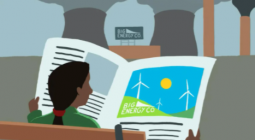Carbon Labeling: How Seriously Would You Take It?

Some companies are calling for carbon labeling on consumer products, created and regulated by the UK’s Carbon Trust, as a way to provide buyers with an idea of the emissions generated by products, a move that would hopefully increase awareness of the issue and perhaps even persuade us to buy goods with a lower carbon footprint.
Carbon labeling follows in the footsteps of the nutrition facts on food labels and would include the production factors related to the item throughout its entire value chain, specifically, raw materials, manufacturing processes, transportation, use of the product, and disposal. Which is all well and good, except that nutrition labels have been around for some time now and do not seem to have done much to counter the obesity epidemic in many countries. If carbon labeling has the same impact on emissions, we could find ourselves facing a climate apocalypse sooner rather than later.
There’s no doubt that evaluating the emissions involved in making something is a good idea. The problem is that doing so is a complicated business, as companies like New Zealand sneaker maker Allbirds make clear in its open source manuals on the subject, and are easy to falsify. Using this type of labeling for marketing and greenwashing purposes is easy, and even more so when its implementation is progressive and some companies can get ahead of the curve and position themselves as leaders in their categories while we still don’t have all the information required to do the job properly. As long as consumers still don’t have a clear idea about the production standards that should set the norm, including quantities on a label can be completely misleading, all that such labelling is likely to do is create misinformation.
Assessing consumer goods’ contribution to carbon dioxide levels could certainly help prevent some harmful practices by establishing metrics that have to be accepted by all competitors in an industry. Taking the best practices for one product category and imposing them as a standard for its competitors and penalizing those who do not comply could help reduce emissions, rather than simply leaving ill-informed consumers to decide. At the same time, placing the burden of responsibility for reducing carbon dioxide emissions with users, or sitting back and saying “the market just doesn’t see it as a deciding factor” is going about things the wrong way.
How seriously would you take the information on a carbon label when making a purchasing decision? Would you spend time comparing labels, or would the information they contain be irrelevant, due to a lack of context?
21 June 2021
Forbes




